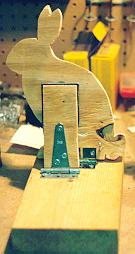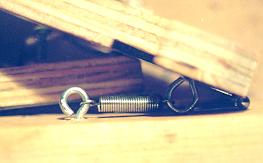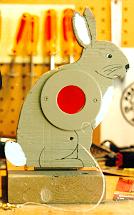Make Your Own Field Target
By Brad Troyer
click the ad to visit this advertiser, View All Advertisers On This Page
Whether you are starting a new club or wanting some inexpensive practice targets, this wood design Field Target is a great way to go. Building these field targets only requires a few common tools found in just about any home. The design has proven to be both reliable and durable. The basic design was first given to me by Rodney Boyce. I modified it slightly by adding a spring and tension screw adjustment.
Described below are the materials, tools, and process I use to make my targets. You will find that as you make one or more of them you will find different/better ways to make them. You will be able to use other tools and parts other than what I use and specify. I encourage you to experiment with the design. If you come up with unique/better designs, let me know.
I only buy the hardware for my targets. I get the face plate plywood and base from scrap wood I found at a local woodworking shop and fencing company. This helps to keep the cost way down. With the hardware used for these targets, I can make two targets for under $10. The parts can be bought at any home improvement or hardware store. I also bought the steel plate used for a paddle from a local welding shop. They had a lot of scrap metal laying around and they donít charge me much for the small amount I use.
I use an industrial washer to surround the kill zone. Be careful when buying these. A 1 1/2" washer has an inside diameter of about 1 5/8". I usually get one size smaller washer for what ever size of kill zone I want, ie. for a 1" kill zone I get a 7/8" washer. These washers can be bought at a hardware store, local nut and bolt shop, or industrial supply house.
Parts List (one target)
- 1 - 2" utility hinge
- 1 - 2 1/2" Tee hinge
- 1 - 1/4" x 2" hex bolt
- 1 - 1/4" hex nut
- 1 - industrial washer
- 4 - 5/8" #6 wood screws
- 1 - 1" #8 Phillips sheet metal screw
- 1 - 1 7/8" 0.35 spring
- 1 - 2í reset cord, nylon or Dacron fishing line
- 1 - U nail
- 2 - eyelet screws
- 1 - 2" x 2 1/2" x 1/8" steel plate
- 1 - piece 3/4" Plywood for face plate & paddle arm
- 1 - 2" x 6" x 12" pressure treated lumber for the target base
Suggested Tools
- Power Drill
- Wood & Metal Drill Bits
- Saber Saw
- Metal File
- Screw Driver
- Hack Saw
- Sandpaper

This first step is to cut out the kill zone and face plate. I like to use pictures of real animals that I get off of the computer or out of magazines. I copy them, cut them out, and glue them to the plywood using rubber cement. In choosing a target face, keep in mind that a kill zone paddle will be behind the target face. You want to make sure that the kill zone placement will allow the paddle to be behind the target face and not visible when the target is complete. I would also recommend that you make two copies so that you have a copy to refer to when you paint the face plate later on.
Once the animal stencil is glued to the plywood, I like to drill out the kill zone. I usually place the industrial washer on the face plate in the appropriate area and trace the kill zone. Next I use a wood drill or hole saw to cut out the kill zone. I usually make the hole a bit bigger than the washer size, but you donít have too. If you donít have large wood drill bits, you can use the Saber Saw to cut the hole. With the kill zone cut, next cut out the face plate with a Saber saw.

Now mount the kill zone washer around the kill zone on the face plate. I drill two holes in the washers near the edges on opposite sides of the washer. I then mount it to the face plate with two 5/8" # 6 wood screws.

The face plate can now be mounted to the base using the 2" hinge. Leave about 1 1/2" in front of the target face for stakes.

Now cut the paddle arm. I usually use some left over 3/4" plywood for the arm. I cut it to 1 1/2" or 2" width (depending on the kill zone size). To cut the height, place the arm next to the face plate and draw a line where the top of the kill zone and paddle are meet.
The paddle arm can now be mounted to the base behind the face plate using the 2 1/2" Tee hinge. Leave about 1/2" between the paddle arm and face plate. Make sure the paddle arm is centered with the kill zone hole.

Now mount the metal paddle to the paddle arm. You may need to cut the metal to the required size for the paddle. I usually use my Saber saw and a bi-metal blade to cut the paddle but a simple hack saw will work too. I like to make the paddle 1" higher and 1/2" wider than the kill zone. I use two 5/8 # 6 wood screws to secure the paddle to the paddle arm. Make sure that about 1/8"-1/4" of the paddle extends above the paddle arm. The top of the paddle are is part of the sear mechanism that stops the target from falling on a missed shot.
If you donít want to use a metal plate for a paddle, a large washer and bolt can be used instead. I like to use a large 1/2" washer and a 5/8" X 1" carriage bolt. You will need to make the paddle are a bit longer and file a flat spot in the washer. Drill a 5/8" hole in the paddle arm that is centered with the kill zone. Install the washer with the bolt and position the flat spot at the top of the paddle arm before tightening the nut.


The next thing to do is install the 1/4" hex bolt that makes up the sear mechanism. This is the most important step in the process so be careful and take your time. Set the target face and paddle arm so that they are vertical. Use a pencil and set it flat on top of the paddle and make sure it is perpendicular to the paddle arm. Make a mark where the pencil touches the target face. Measure down 1/16" and make another mark. This is where you will drill your hole for the hex bolt. Drill the hole with a 3/16" drill bit. This bit will leave the hole small enough that you can tap the hole with the hex bolt. As you drill, tilt the drill upward, away from the to of the paddle so that when the hex bolt is installed, it will be angled slightly upward. Be careful not to drill all the way through the front of the target face.
Now take the hex bolt and screw it into the hole. Once it is tight, cut off the head of the hex bolt. I like to remove the bolt from the target face to cut it off. I also like to cut off about 1/4" of the threads so that the threads donít extend out of the face plate (this isnít necessary for proper target operation however).
Use a metal file and some fine sand paper to smooth the edge on the paddle top and the hex bolt where the head was cut off. Burs and rough edges may make the target malfunction.


Now install an sear adjustment screw into the paddle arm. Use the 1" #8 Phillips sheet metal screw and screw it into the paddle arm about 1/2" below the paddle and off to one side. This screw will adjust how far the paddle will move down the hex bolt toward the target face. Set the screw so that the paddle is completely seated on the hex bolt, just past the end of the hex bolt. This is just a gross adjustment, the final adjustment can be made later.
Now drill the hole in the face plate that will allow the reset string to pass through it and be attached to the paddle arm. I like to position it off center of the kill zone. I usually position the hole so that it will be on the opposite side of the sear adjustment screw on the paddle arm. I put the hole about 1" below the kill zone washer, but it depends on the size of the target. You want the hole to be above the mid point of the paddle arm if possible.
Once the hole is drilled into the target face, install a U nail on the paddle arm. This is where the reset string will be attached to the paddle arm. A finishing nail can be used if you donít want have any U nail. Just hammer the finishing nail in a bit and bend it over so that you can tie the reset string to it. The nail should be positioned at the same height as the hole on the target face when the target face and paddle arm are vertical. Try to keep the nail above the mid point of the paddle arm, this will make resetting the target easier.
Now install the reset cord. I like to use Dacron 50 lb. test fishing line. This is rather expensive but very strong. You can use nylon cord also. Tie one end to the paddle arm an feed the other end through the target face. Tie a loop in the free end. This is where you will attach the reset string.


Next install the tension spring. Install one eyelet screw into the target face about 1/2"-3/4" above the bottom and 3/4" to one side of the paddle arm. The opening should be facing upward when installed. Install the 1 7/8" 0.32 spring into the eyelet screw and install another eyelet screw on the free end of the spring. Now set the paddle arm and target face in the down position. Pull the spring and eyelet screw back to the rear of the target base. Mark where the eyelet contacts the target base. Now install the second eyelet screw at the mark on the target base. The opening on this eyelet screw should face rearward. Now install the free end of the spring on the open eyelet screw . You may want to turn the eyelet screw to make the installation easier. The trick here is to position the eyelet screw on the base so that there is no tension on the spring when the target has fallen. Also, don't position the target face eyelet screw too high as that will make the spring tension greater and make the target harder to reset. The spring is meant only to pull the target face back enought to make it fall over.
Now drill some holes in the target base for staking the target down. I use 12" spikes for this purpose and I drill 1/2" holes for them. I use two in the rear and one in the front of the target.

Now you are ready to test the target. Adjust the sear adjust screw (on the paddle arm ) until you can trip the target by hand with a pen or pencil. I like to use an old Daisy pump gun for testing. With three pumps it will generate about 300 fps. When the target falls over with three pumps, the sear adjustment is done. With the sear adjusted, try shooting the target with an airgun at about 10 yards. Shoot the paddle and make sure it falls over. Also shoot the washer around the kill zone and make sure it doesnít fall over with a miss.



The target is basically complete except for painting. Typically, the paddle is painted Dayglow Orange. A white base coat is nice as it makes the orange very bright. The face plate can be painted any color you want, typically a color similar to the natural animal color is used. I spray paint the base color and then add the details with some black and white latex paint.
This target design can be used with just about any animal face plate
that you can imagine.
Click here for some of my target face designs that you can use for your targets

Back to Field Target
Back to General Airgun Information
Back to American Airgun Home
Top of Page

click the ad to visit this advertiser, View All Advertisers On This Page
© Copyright 2006 by Brad Troyer & American Airguns


